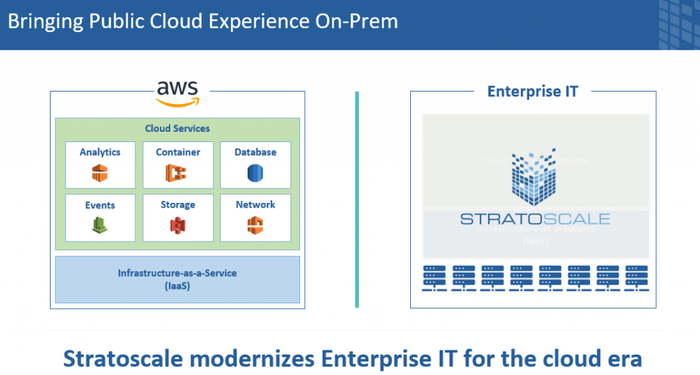New software platform features aim to create a more complete hybrid cloud operating model.
May 22, 2019

Stratoscale is adding more features to its namesake platform that is the foundation of the vendor’s efforts to develop an on-premises computing environment that offers many of the capabilities and features found in public clouds.
The six-year-old company this week unveiled Stratoscale V5, which offers new managed open-source functionality that’s key for running cloud-native workloads in both in enterprise data centers and at the edge, as well as improved identity management, database replication, notification features and DNS services.
The upgraded platform is part of Stratoscale’s larger plan to create a platform that changes how data centers have run for the past couple of decades by creating a cloud-like environment that mirrors in large part what Amazon Web Services (AWS) and other top cloud providers offer, according to John Mao, vice president of business development at Stratoscale.
Doing so not only would make it easier for enterprises to embrace hybrid and multicloud strategies, but also would bring many of the benefits that public clouds offer – such as speed, agility and lower costs – on premises.

Stratoscale’s John Mao
“We have a software platform that helps transform enterprise IT into what you can think of as a little mini service provider internally to give the same types of capabilities and to give the same managed experience that the public cloud offers to CIOs all over the world, but out of their own data centers to help reduce costs, to help improve performance and to help meet regulatory concerns,” Mao told Channel Futures.
Statoscale wants to address the growing trend among enterprises to adopt multicloud and hybrid cloud initiatives, keeping some workloads on-premises while running others in more than one public cloud. However, it’s more than simply running applications in a data center and in the cloud, he said.
“The reality is that that’s not true because … if you’re comparing Amazon to what most IT is running, which is VMware today, those are not the same things,” Mao said. “They are very, very different animals. You access them differently, you build applications on them differently, you manage them differently. Everything is different. … To achieve true hybrid, you have to bring parity into the private enterprise data center by having [the same] functionality as in the public cloud. You have to make those things equal to bring that level of parity. Once you have a level of parity in terms of capabilities, then you’re actually able to offer a true hybrid experience.”
 Some vendors are beginning to do this, but Stratoscale has implemented a set of public cloud management APIs around its platform to ensure a single operating model to both the public cloud and the on-premises environment, allowing for a seamless hybrid and management strategy rather than having to manage different stacks, he said.
Some vendors are beginning to do this, but Stratoscale has implemented a set of public cloud management APIs around its platform to ensure a single operating model to both the public cloud and the on-premises environment, allowing for a seamless hybrid and management strategy rather than having to manage different stacks, he said.
For example, AWS-compatible APIs in the Stratoscale platform means that “when your application or your CIO looks at your enterprise data center and then they look at AWS, they actually see the same thing,” Mao said. “We don’t do everything Amazon does, but the core capabilities that they need are all there and they’re now able to manage it in the exact same way.”
Stratoscale’s strategy dovetails with what channel partner Data Sciences Corp. is seeing in the market.
“The rate of hybrid cloud adoption is accelerating as organizations seek to deliver faster on market demands and realization sets in that public cloud-only strategies are not a silver bullet,” Werner Coetzee, head of business development at Data Sciences, told Channel Futures. “The complexities of pivoting to a cloud-native organization go beyond …
… technology and running your workloads in a public cloud provider’s data center. Self-aware organizations [that] recognize that sustainable change requires a transitional platform are aggressively developing their cloud-native skills and operational models in-house, where barriers to adoption are lower and the impact of failure is better understood.”
Stratoscale’s vision addresses the need of enterprises to adopt more cloud-native operating models and allows Data Sciences to “craft in-house, cloud-native platforms that enable organizations to transform their operational models and technology portfolio at a rate that their organization can sustain while allowing rapid time-to-value delivery of new services,” Coatzee said.
Key to Stratoscale V5 are the public cloud APIs that give application owners and developers a hybrid cloud experience that is easy to deploy and can be economically managed at scale, he said.
With Stratoscale V5, the company offers petabyte scale S3 with open-source CEPH and adds managed Redis and MongoDB services to its lineup of managed databases. There also is site-to-site disaster recovery – including object storage – no downtime upgrades and message busses.
It follows Version 4, which included a host of cloud functionalities and managed services around databases, object storage, Kubernetes, Hadoop, managed virtual machines and load balancers.
Stratoscale’s Mao said his company’s efforts to build out an on-premises cloud platform shouldn’t be read as being anti-public cloud.
“I’m actually a big believer in public cloud,” he said. “I’m a huge advocate because it really pushes the industry to change how we’ve been doing things over the last couple of decades and it’s brought about new advancements and a whole new level of speed and agility, which is great for the world as a whole — because in principle, it brings about a lot of efficiency. … The reality is it’s not a one-size-fits-all solution for all problems that business will ever cover.”
Read more about:
VARs/SIsAbout the Author(s)
You May Also Like


